Lāhainā, One Year Later
Editor’s Note: In February 2024, we sent Beau Flemister from his home in O‘ahu to report on the state of West Maui as the community rebuilds after the deadly wildfire that decimated the historic town of Lāhainā. This is an ongoing situation. Since this was reported, there have been changes and progress in the area.
In West Maui there is legend of the Kaua‘ula wind, a demon-like gale that funnels down the mountains, through the Kaua‘ula Valley, straight into seaside Lāhainā town, destroying everything in its path. It is said that when the Kaua‘ula wind blows, it kicks up dust that blocks out the sun, obscuring the sight of neighboring Hawaiian Islands Lāna‘i and Moloka‘i, normally visible just across the ocean channels. Even in Native Hawaiian moʻolelo (oral history), this terrible wind does not blow, but roars.
On August 8, 2023, that legend turned into a reality. High winds roared through Kaua‘ula Valley, fueling the flames that had been sparked by downed powerlines near Lāhainā. The fire quickly spread, taking 100 lives and razing 2,200 structures. It was the deadliest wildfire in modern U.S. history.
Six months later, on a sunny February day, I find myself in the passenger seat of a lifted Ram 1500 belonging to filmmaker and big-wave surfer Matty Schweitzer. It’s one of those unusual late-winter days in West Maui when the wind is completely dead. There is not a cloud in the sky, and the silvery, still ocean looks like a freshly Zamboni’d ice rink. But countless signs of love, support, mourning and frustration still line Honoapi‘ilani Highway. A scraggly “WE ARE LĀHAINĀ STRONG” mantra is spray-painted over the arch of a tunnel. To my left, I see the charred and flattened remains of Old Lāhainā Town.
A bird’s eye view of Lāhainā town after the fire. Photos: Ryan ‘Chachi’ Craig
A bird’s eye view of Lāhainā town after the fire. Photos: Ryan ‘Chachi’ Craig
A bird’s eye view of Lāhainā town after the fire. Photos: Ryan ‘Chachi’ Craig
I’ve come to West Maui to learn more about the community’s ongoing efforts toward rehabilitation, and Matty—who has stories of his own from this tragic event—is my local chaperone.
Matty and his brother Zane (also a big-wave surfer and world-champion waterman) were in California competing in a motocross competition on the day of the fires. Matty had potentially broken some ribs in the event, and the two were waiting at the doctor’s office for an X-ray when the calls and texts began to come through. One was from Matty’s wife, who was at home with their three young kids, describing how hard the wind was blowing.
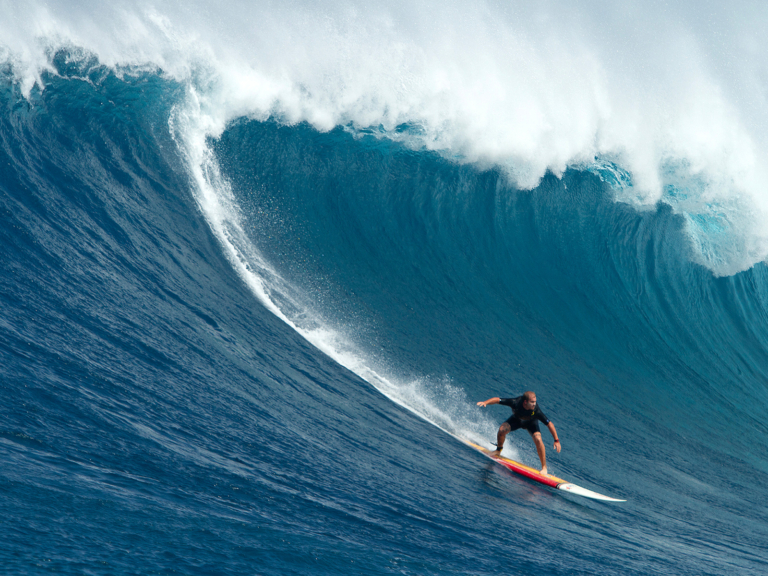
Our local guide Matty Schweitzer is Maui born and bred. When there’s a swell, you can find him paddling into bombs like this at Peʻahi. Photo: Erik Aeder
At the time, Matty didn’t think much of it. That’s Maui. It’s windy.
Not long after, their dad (an 18-time World Champion windsurfer) called and told them that in all his life, he’d never seen anything like this wind. He told them a fire had started in Kula and if one started in Lāhainā (as it had in 2018), it would be big trouble. Then they got a text from a friend who was panicking, saying that the town was on fire and that he was trapped. Then: nothing. No more texts came in, no more calls went through.
“Suddenly, it got really scary,” said Matty, swallowing and pausing to regain his composure.
They booked it to the airport, and after pleading with a benevolent ticket agent, they somehow got on a near-empty Hawaiian Airlines flight to Maui, alongside a few media reporters. Most flights weren’t letting anyone land at Kahului Airport. It was 36 hours before the brothers would see their families again.
Like many people within Maui’s big-wave surf community, Matty and Zane have a unique skillset and résumé for a natural disaster such as this. They can operate Jet Skis in treacherous ocean conditions, know how to keep their cool under pressure and have experience in first response medical care.
Once on the island, the brothers jumped into action alongside dozens of others from Maui’s community of watermen and women, big-wave surfers, water-safety operators and commercial fisherman, who were able to get lifesaving supplies to those in need far quicker than government agencies or American Red Cross.
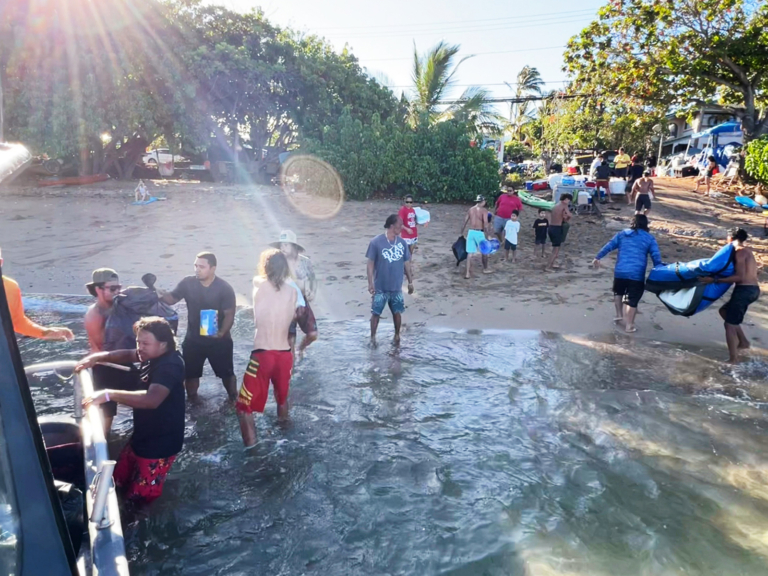
The road to recovery for Maui has been long, but things tend to move a lot faster when the local community jumps in. Photo: Matty Schweitzer
“That first view I got of Lāhainā was on the Jet Ski from the water, still smoldering, coming up from Ma‘alaea,” recalls Matty, looking out to sea. “Seeing your town and everything you know just completely gone … that was heavy.”
Matty’s first order of business was to set up one of the first supply hubs in West Maui at the Kahana boat ramp, unloading goods from boats that were bringing them in from neighboring communities. Then he started collecting VHF radios from fishermen’s boats and set up a communications center at Kahana to correspond with neighboring islands, since phone lines and cell towers were down. He’d eventually use the radios to communicate with boats and planes, calling in everything from insulin to diapers.
The brothers got a Starlink device and set up an internet base for folks in the community. Matty regularly operated a drone for his film work, and people would ask him to fly it over the burn zones to see if their houses were still there, often receiving the tragic news that they no longer existed.
“Two weeks later, after the adrenaline wore off, it still felt like there wasn’t a lot of help,” says Matty.
Slowly, Red Cross and the Federal Emergency Management Agency (FEMA) came in and set up convergence zones, but before them, the community took things into their own hands.
“Let me take you to the beach,” Matty says, hooking into Ka‘anapali. Five minutes north of the ashen remains of historic Lāhainā town, we’re in resort land. The road borders an emerald golf course; sprinklers shoot water into the air carelessly to feed the fairways. I spot polo-shirted tourists wearing spiked shoes, while others stroll the sidewalks with shopping bags.
We drive toward the ocean and park behind the restaurant Leilani’s on the Beach, but the view of the sea is blocked by a line of tents and black tarps, with signs of protest reading: “Keep Lāhainā Lands In Lāhainā Hands” and “Every Day A Local Family Moves Away.” Behind the tents, a row of fishing poles in rod holders lines the shore.
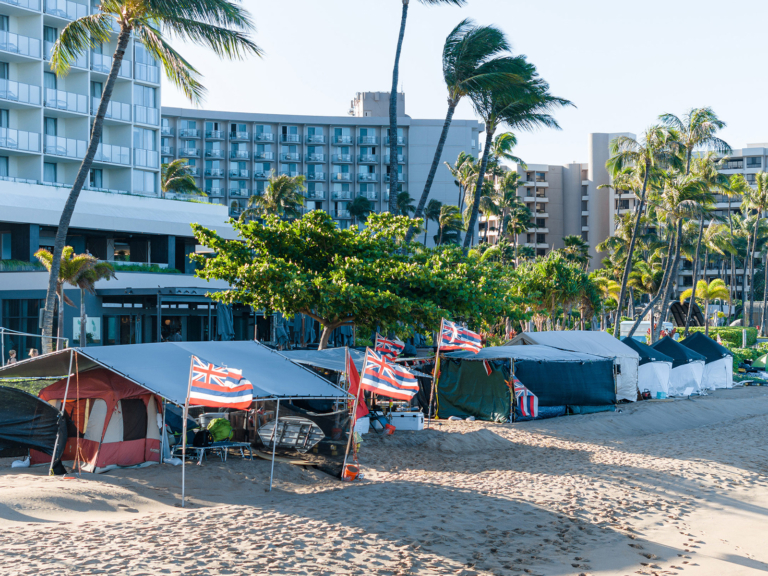
A group of Lāhainā wildfire survivors set up camp on a popular resort beach to pressure the mayor to use his emergency powers to convert short-term rentals to long-term housing for residents in need. Photo: Ryan ‘Chachi’ Craig
We enter one of the transitional structures on the beach. The inside is sandy, crammed with sleeping cots, food supplies, boxes of clothing and various tables and chairs. The space certainly looks more lived in than just a temporary situation.
Inside, Matty introduces me to De Andre Makakoa, whose home burned down on August 8, leaving him, his pregnant wife and baby daughter suddenly without a home. De Andre is a community organizer and videographer for the Lāhainā Strong coalition—a grassroots organization that advocates for the community. On November 10, 2023, Lāhainā Strong organized a “fish-in for dignified housing” to raise awareness about critical housing needs and the ongoing shortage since the fires. As of February, over three months later, the social demonstration is going strong.
“This is a political occupation,” De Andre says, referring to the tents and structures on the beach. “We are set up here in protest to urge our mayor and governor to use their emergency powers to convert short-term rentals into long-term housing for our people.”
De Andre explains that there are still nearly 6,000 people on Maui displaced from the fires, most without long-term housing. [Editor’s note: As of publishing, that number is now closer to 3,000.] Many are living in hotels, undignified and cramped. Some have no laundry, no privacy and nowhere to cook food, and have been bounced around from hotel to hotel and from room to room.
Rather than just creating more housing, Lāhainā Strong advocates for converting the surplus of short-term rentals into housing for displaced residents. The lack of housing has been a hot-button issue on every island for years; the fires simply intensified it.

Lāhainā Strong. A look at the supply hub supporting the months-long fishing occupation in Ka‘anapali. Photo: Ryan ‘Chachi’ Craig
“And the fishing part?” I ask De Andre, wondering about the ever-present fishing rods along the shore behind the temporary structures.
“Right now, we’re leveraging our right as Native Hawaiians under the Hawai‘i Revised Statute, where by law, we have the right to practice our Native Hawaiian rights whenever and wherever we wish to do so. Fishing is one of those native cultural practices. It’s illegal to camp on the beach, but you can fish for as long as you want.”
“So, just fishing 24-7,” I say, with a smirk.
“Yeah, fishing 24-7,” he grins. “We haven’t caught any fish yet, or housing.”
There’s usually between three to 30 people present at the occupation at a time—enough to be an eyesore to tourists, who’ve been sold a picture of paradise; the beachfront dream now shares space with a political movement.
“Actually, the hotels are in support of us as well,” says De Andre. “When you think about it, our demands are that you turn short-term rentals into long-term housing. So, if that happens, we won’t have Airbnb’s in our neighborhoods anymore and where do the tourists have to stay?”
“There?” I ask, motioning to the high-rises behind us.
He nods, bingo. “They leave the bathrooms open for us, they give us rice and ice. They’re sympathetic to our cause.”
Initially, Hawaii Governor Josh Green proposed housing those displaced by the fires in short-term rental units, and threatened a moratorium on short-term vacation rentals if those needs were not met. Then, in March 2024, he said he would not pursue a moratorium as enough housing units had been found. Yet many residents still don’t have long-term housing. [Editor’s note: The demonstration concluded on the first week of May 2024. In late July, the Maui Planning Commission voted 5-0 in favor of quickly phasing out short-term housing in West Maui. If approved, the bill would go into effect on July 1, 2025.]
After talking with De Andre, Matty drives us uphill from the beach and parks at what appears to be a large public park. An inflated bounce castle stands on a grassy soccer field, shaking from the weight of children leaping and laughing within. Pop-up tents, open shipping containers and semi-permanent refugee-like structures line a corner of the field. In the immediate aftermath of the fire, when electricity, communication and roads were closed off, the community sprang into action and created their own distribution hubs for critical food and supplies. This one, called Nāpili Noho, was one of the first and remains one of the few still operating in West Maui.
“Let’s go meet Mel,” says Matty. “She’s been essential to an operation like this.”
We pass a tent that resembles a small general store and enter what appears to be a command center with a sturdy wooden roof placed between two shipping containers. Several folks work on laptops between bites of their lunch. I am introduced to Melonee Lujan, who goes by Mel.
A Maui native, Mel is the glue that holds this hub together (though she would never admit it). While the big-wave community had crucial skills for the initial relief efforts, helping transport goods from sea to shore, Mel had another skillset that proved indispensable.
Melonee Lujan is key to the Nāpili Park Emergency Community Resource Center. This hub includes a grocery store where affected households can access food, toiletries and other essentials daily, all at no cost. These supplies are entirely funded and provided through donations. Photos: Ryan ‘Chachi’ Craig
Melonee Lujan is key to the Nāpili Park Emergency Community Resource Center. This hub includes a grocery store where affected households can access food, toiletries and other essentials daily, all at no cost. These supplies are entirely funded and provided through donations. Photos: Ryan ‘Chachi’ Craig
Melonee Lujan is key to the Nāpili Park Emergency Community Resource Center. This hub includes a grocery store where affected households can access food, toiletries and other essentials daily, all at no cost. These supplies are entirely funded and provided through donations. Photos: Ryan ‘Chachi’ Craig
A self-described data nerd, Mel lived in Upcountry Maui before moving to Las Vegas where she did employment forecasting. When news of the fires hit, she couldn’t get in contact with a cousin who owned a tattoo and surf shop in Lāhainā. With no word a week later, she got on a plane to look for her cousin.
On her flight to Maui, she had a feeling that no one was tracking what donations were being distributed. So from the airplane, she created a quick-fix system that could start the process. She arrived and went straight to the Nāpili Noho hub, serendipitously finding her cousin there shortly after.
Realizing the scope of the disaster, Mel quit her remote job in Vegas, flew her husband over and has been in Maui ever since. She revamped and refined the system she created, differentiating folks by three categories: folks who lost everything, folks who were displaced but had a home they couldn’t return to yet, and folks who became unemployed after the fires. Most coming to the hub for supplies fit at least two of the three categories. Within the first month, her system showed that the Nāpili Noho hub had served 2,400 families (averaging three to five people per family). By the end of 2023, Nāpili Noho and the other hubs in West Maui distributed over 450,000 items of donated food and clothing.
As of February, the Nāpili Noho hub services 162 families a day (around 400–600 people), providing hot food, meals, clothing, bedding, lomi lomi massage and, most importantly, an understood safe space for the community.
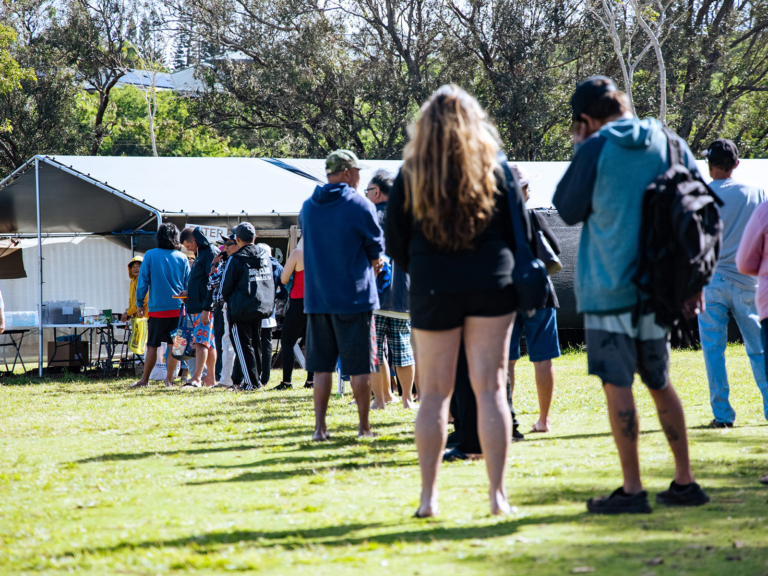
The long line outside the Nāpili Noho hub in Nāpili Park serves as a reminder that the struggle is not over yet, and Lāhainā is a long way from being rebuilt. Photo: Ryan ‘Chachi’ Craig
“I view the hub as one of the safest places for people to come,” says Mel. “There’s bounce houses up for kids, and people use the walk-in store as a place to decompress, or even a place to cry while their children are bouncing. We have music and movie nights in the park. Beyond receiving donated supplies that you need, it’s a safe place to let out your frustrations.”
“There were people that lost everything,” says Matty as we head back to his truck. “But they came to the hubs not to grab stuff—but to help. Time and time again, I’d talk with people who were in a bad spot, but they always felt like someone had it worse.”
Later that night, Matty puts me up in a bunk in his outdoor toolshed/man cave. Throughout the night I can hear the weather transform, and I eventually awake to a stormy, wet morning.
We hop in the truck and head toward Olowalu to meet Eddy Garcia, a regenerative farmer, surfer and the executive director of the nonprofit Regenerative Education Centers. Eddy has been pivotal in providing housing solutions for displaced residents and in stewarding the land where families will have these homes.
Eddy, sun-tanned and wearing boardshorts, greets us with a smile. He’s barefoot and standing shin-deep in a flooded parking lot, but remains chipper and talkative as he guides us through the swamped maze between Matson shipping containers.
Well before the August 8 fire, Eddy and his nonprofit were teaching folks in the community how to build tiny homesteads, grow their own food and cultivate their land in order to live sustainably for years to come. “We teach people about regenerative agriculture, stewardship and homesteading,” he explains, leading us to an opening behind the large containers filled with plants in aquaponic growing systems.
Once the fires happened, his nonprofit received donations to both feed people and build them tiny homes—temporary housing intended for families to keep permanently as an ADU once they eventually build regular homes back on their own land. Eddy’s nonprofit has over 100 shipping containers that they’re retrofitting into off-grid, self-sufficient homesteads with solar systems, bathrooms and kitchens. These homes can be set up on agricultural land made available through Eddy’s program or on host families’ land until residents are allowed to go back on their own properties.
The organization has a list of 400 people whose homes burned down and is giving these homes to roughly 100 people that are most in need.
“It’s going to be a couple years before permanent housing is built, so we’re providing creative ways for folks who lost their homes to live. And not even just housing, but off-grid, self-sufficient homesteads,” Eddy says.
He motions us over and we wade through more water to some raised gardens and mounds brimming with fruits and vegetables of all kinds. The sheer amount of growth and produce flourishing in the plots is astounding.
He points down to a mutant-like vegetable growing off a vine and says, “Check this out.” It’s a squash the size of an inflated rugby ball. Eddie already has 60,000 pounds of food in the ground and is on schedule to grow hundreds of thousands of pounds of food to feed the community.
Having lived off-grid for years, Eddy Garcia is now teaching the importance of self-sufficiency to those in need. His nonprofit is also setting up off-grid interim housing solutions, farming and food programs to support displaced residents. Photos: Ryan ‘Chachi’ Craig
Having lived off-grid for years, Eddy Garcia is now teaching the importance of self-sufficiency to those in need. His nonprofit is also setting up off-grid interim housing solutions, farming and food programs to support displaced residents. Photos: Ryan ‘Chachi’ Craig
Having lived off-grid for years, Eddy Garcia is now teaching the importance of self-sufficiency to those in need. His nonprofit is also setting up off-grid interim housing solutions, farming and food programs to support displaced residents. Photos: Ryan ‘Chachi’ Craig
It’s slow going, but as a farmer, he’s used to that.
The next day, Matty drives me back to the airport. The wind has kicked back up, whistling wildly through the truck’s window. But there’s nothing dry about the day. Rain sweeps across the road in angular fits and spasms. While we drive, Matty takes calls on speakerphone. Most of his conversations are connecting the dots to help families get what they need. Recovery from an event this destructive is a long road. But none of the people I’ve met the last few days are the type to fall asleep at the wheel.
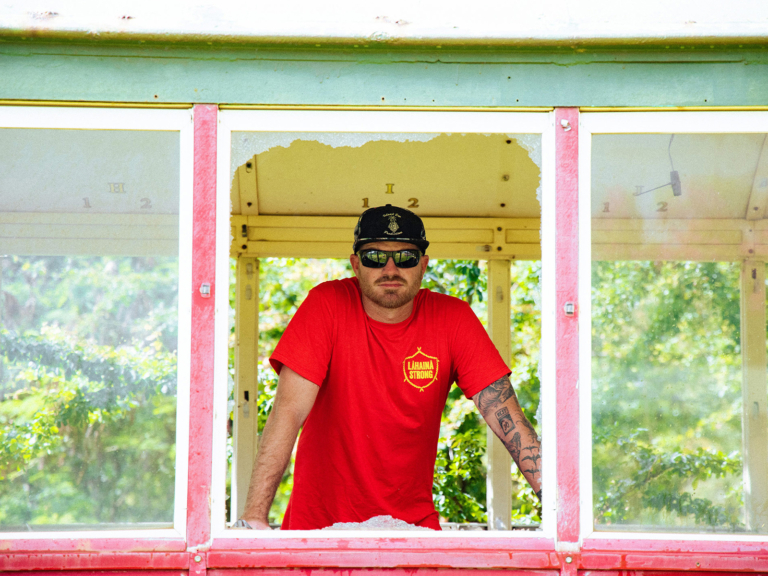
Rebuilding a community takes a team effort. Matty is a prime example of the many individuals who have stepped up to help their neighbors and rebuild a stronger Lāhainā. Photo: Ryan ‘Chachi’ Craig
“At first there was no order,” recalls Matty. “But it was pretty mind boggling how much order the community had. There was no looting, no rioting, hardly any fights; it was just the community coming together to help each other.”
To support and learn more about Lāhainā Strong’s ongoing effort to rebuild and revive their community after the fire, head here.
Interested in more activism stories?
Don’t miss the latest environmental stories, action alerts and other ways you can help save our home planet. Join us at Patagonia Action Works today.










